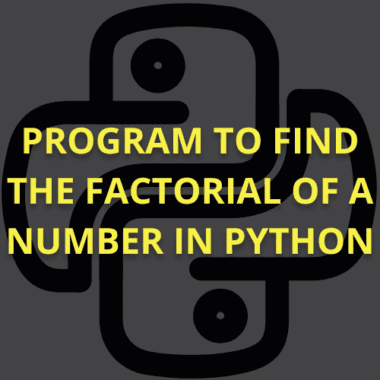Summary: Python’s versatility and simplicity make it indispensable across various industries. It powers real-time applications like Data Analysis, web development, and AI. With robust libraries and a strong community, Python fosters innovation in fields ranging from finance and healthcare to gaming and scientific research.
Introduction
Python is a widely acclaimed programming language. Its growing number of real-world applications and uses shows its increasing relevance in tech.
In other words, Python’s applicability spans numerous domains. It is a powerful and accessible tool for a broad spectrum of applications. All this has made Python one of the most sought-after programming languages. A Python developer gets ₹5,00000 per year in India.
In this blog, we will explore the features and applications of Python and the importance of Python programming. If you are considering learning Python from scratch, you must not skip reading this blog.
What is Python?
Python is a high-level, versatile programming language known for its readability and simplicity. Developers use Python to build web applications, automate tasks, analyse data, and create Machine Learning models. Python’s extensive standard library and supportive community make it popular for beginners and experienced programmers.
Python’s syntax emphasises readability, reducing the cost of program maintenance. It supports multiple programming paradigms, including procedural, object-oriented, and functional programming. With its dynamic typing and memory management, Python accelerates development and prototyping, making it a preferred language for rapid application development.
Why is Python Important?
Python is necessary due to its versatility and simplicity. Its clear syntax allows beginners to grasp programming concepts quickly while enabling experts to work efficiently. Python’s extensive libraries support various fields, from web development to Data Science and Machine Learning.
Its cross-platform compatibility ensures seamless development across different operating systems. Python also fosters a robust community that contributes to its continuous improvement and extensive resources. The language’s popularity in academic and professional settings solidifies its role as a critical tool for problem-solving and innovation in the tech industry.
Key Features of Python
Python is a versatile and powerful programming language known for its simplicity and readability. Due to its extensive features and capabilities, it has become one of the most popular languages for beginners and professionals. Below are some key features that make Python stand out.
Easy to Read and Write
Python’s syntax is clear and concise, making it easy to learn and use. Its readability promotes good programming practices and reduces the cost of program maintenance. Indentation to define blocks of code eliminates the need for braces or semicolons, making the code look clean and straightforward.
Interpreted Language
Python is an interpreted language, meaning the code is executed line-by-line, making debugging easier and quicker. This feature allows developers to test and modify their code without compiling, providing immediate feedback and streamlining the development process.
Dynamically Typed
In Python, you do not need to explicitly declare a variable’s type. The type is determined at runtime, which provides flexibility and reduces the amount of boilerplate code. This dynamic typing system allows for more rapid development and experimentation.
Extensive Standard Library
Python boasts a rich library that supports many common programming tasks, such as file I/O, system calls, and web services. This library reduces the need for writing code from scratch, allowing developers to leverage pre-existing modules and focus on their projects’ unique aspects.
Object-Oriented and Functional Programming
Python supports both object-oriented and functional programming paradigms. This dual support allows developers to choose the best project approach, promoting code reuse and modularity. Object-oriented programming in Python involves creating classes and objects, while functional programming uses functions as first-class citizens.
Platform Independence
Python is a cross-platform language, meaning that Python programs can run on various operating systems without modification. This portability is a significant advantage, as developers can write code once and run it anywhere, from Windows and macOS to Linux and beyond.
Strong Community and Ecosystem
Python has a robust and active community that contributes to its growth and development. This community support is evident through numerous tutorials, forums, and conferences. Additionally, Python’s ecosystem includes a vast array of third-party packages and libraries available through the Python Package Index (PyPI), making it easier to implement complex functionalities.
Integration Capabilities
Python excels at integrating with other languages and technologies. It can easily interface with C, C++, Java, and .NET components, making it a versatile choice for projects that require interoperability with other systems and applications.
Top 10 Uses of Python in Real-world
Python, often recognised for its simplicity and versatility, has emerged as a powerhouse in the programming world. Its applicability spans various domains, and one of its notable strengths is its real-time capabilities. Here are some of the critical Python applications in the real world:
Real-Time Data Analysis
Python can quickly process, analyse, and provide insights. One critical application of Python programming is making timely data-driven decisions. Many organisations depend on Python to stay competitive and agile in a fast-paced environment.
Web Development
Python is a preferred choice for creating real-time web applications in web development. Frameworks like Django and Flask enable developers to build dynamic and interactive websites that respond in real-time. These applications are used in e-commerce, social networking, and collaborative tools.
Internet of Things (IoT)
One essential application of the Python language is the Internet of Things (IoT). It is used to program IoT devices, allowing them to collect and transmit data in real-time. Python’s ease of use and wide range of libraries make it ideal for IoT applications. Python is critical in this field, from smart home devices to industrial sensors.
Finance and Stock Market Analysis
Financial markets are highly dynamic, and timely analysis is critical. Python is widely adopted for real-time financial analysis and stock market predictions. Its Data Analysis libraries, such as Pandas and NumPy, are ideal for processing real-time market data.
Scientific and Research Applications
Python is a favourite among researchers and scientists for real-time simulations and modelling. Whether it’s simulating physical phenomena or conducting Data Analysis in a laboratory, Python is a reliable tool. It is also integral to scientific computing libraries like SciPy and Matplotlib.
Gaming and Graphics
Python’s versatility extends to the gaming and graphics industry. Game developers use Python to create real-time, interactive gaming experiences. Libraries like Pygame and Panda3D facilitate game development. Python’s easy learning and rapid prototyping make it a popular choice in this field.
Social Media Monitoring
In the age of social media, real-time data is of the utmost importance for marketing and reputation management. Python monitors social media platforms, analyses trends, and promptly engages with users. Python scripts often power sentiment analysis and engagement metrics.
Chatbots and Customer Support
Python creates real-time chatbots that offer immediate customer support. These chatbots can answer queries, provide information, and even troubleshoot issues in real-time, enhancing customer service and reducing response times.
Healthcare and Telemedicine
The healthcare sector benefits from Python’s real-time applications, particularly telemedicine. Python is used for remote patient monitoring, enabling healthcare professionals to access real-time data on patients’ vital signs and health metrics. This technology has proven invaluable, especially recently.
Natural Language Processing (NLP)
Python’s NLTK and spaCy libraries are famous for text analysis, sentiment analysis, and language processing.
Read More: Difference between Ruby and Python.
Real-Time Applications of Python for Students
Python is a versatile programming language that offers numerous real-time applications for students across various fields. Its simplicity and readability make it an ideal choice for beginners, and its robust libraries and frameworks provide potent tools for more advanced projects. Here are some critical real-time applications of Python that students can explore.
Web Development
Python is widely used in web development, allowing students to build dynamic websites and web applications. Frameworks like Django and Flask simplify the process, enabling students to create robust web applications with minimal code.
These frameworks offer features such as authentication, database integration, and URL routing, making it easier for students to focus on the functionality of their applications. By developing their websites, students gain practical experience in web design and front-end and back-end development.
Data Analysis and Visualisation
Python’s powerful libraries, such as Pandas, NumPy, and Matplotlib, make it an excellent Data Analysis and visualisation tool. Students can use Python to collect, clean, and analyse data from various sources, uncovering trends and insights.
It benefits students involved in research projects or those studying economics, social sciences, and biology. By visualising data, students can present their findings in a more accessible and engaging manner, enhancing their academic projects.
Machine Learning and Artificial Intelligence
Python is a leading Machine Learning and artificial intelligence (AI) language. Libraries like TensorFlow, Keras, and Scikit-learn provide students with the tools to build and train Machine Learning models. These models can be used for various applications, such as predicting outcomes, recognising patterns, and automating tasks.
Students can work on projects like handwriting recognition, sentiment analysis, and recommendation systems, gaining hands-on experience in one of the most exciting and rapidly growing technology areas.
Automation and Scripting
Python is an excellent language for automation and scripting, helping students automate repetitive tasks and increase productivity. Libraries like Selenium allow students to automate web browsing tasks, while BeautifulSoup allows for web scraping and data extraction.
Python scripts can also automate file management, data processing, and email sending. By automating mundane tasks, students can focus more on creative and critical thinking activities.
Game Development
For students interested in game development, Python offers libraries such as Pygame that simplify the creation of 2D games. Pygame provides functionalities for handling graphics, sound, and user input, allowing students to bring their game ideas to life. Students can learn programming concepts interactively and enjoyably through game development, enhancing their problem-solving and creativity.
Top Python Case Studies
Python has been instrumental in solving complex problems across various industries, showcasing its versatility and effectiveness in real-world applications. Here are some notable case studies where Python played a crucial role:
The popular social media platform Instagram leverages Python for its backend infrastructure. Python’s simplicity and scalability were critical factors in Instagram’s early growth and ability to handle massive amounts of user-generated content efficiently.
Python frameworks like Django helped Instagram build and seamlessly maintain features such as user profiles, news feeds, and the explore tab. Python’s flexibility enabled Instagram to integrate Machine Learning algorithms for content recommendations and user engagement analytics.
Spotify
Spotify relies on Python for Data Analysis and backend services. Python’s libraries, like Pandas and NumPy, facilitate Spotify’s analysis of user preferences and behaviours, which is crucial for personalised music recommendations.
Moreover, Python frameworks such as Flask are used to build APIs that support Spotify’s seamless interaction between its various services and platforms. Python’s role in data-driven decision-making has been pivotal for Spotify in maintaining its competitive edge in the music streaming industry.
Dropbox
Dropbox, a cloud storage service, owes much of its backend infrastructure to Python. Python’s simplicity, readability, and extensive libraries allowed Dropbox to develop and scale its file storage and synchronisation services rapidly.
Python frameworks like Flask and Celery enabled Dropbox to efficiently handle tasks such as file uploads, sharing, and synchronisation across devices. Python’s robust ecosystem also facilitated the implementation of security features and advanced file indexing algorithms, ensuring data integrity and user privacy.
NASA
NASA uses Python extensively for scientific computing, Data Analysis, and visualisation tasks. Python’s libraries, such as SciPy and AstroPy, are employed for simulations, data processing from space missions, and analysing astronomical data.
Ability of python to handle complex calculations and its integration with visualisation tools like Matplotlib and Plotly make it indispensable for NASA’s research and exploration endeavours. Python’s role in space exploration highlights its reliability and performance in handling mission-critical operations and scientific research.
Reddit, one of the largest online communities, relies heavily on Python for its backend infrastructure and Data Analysis. Python’s versatility allows Reddit to manage user-generated content, handle millions of daily interactions, and provide personalised content recommendations through Machine Learning algorithms.
Python frameworks like Pylons and SQLAlchemy are utilised to build and maintain Reddit’s web applications, ensuring scalability and performance across its vast user base. Python’s role in supporting Reddit’s dynamic and interactive platform underscores its effectiveness in managing large-scale web applications and community-driven content.
Frequently Asked Questions
What are the real-time applications of Python?
Python excels in real-time Data Analysis, web development (using Django and Flask), IoT programming, and financial market analysis. It powers social media monitoring tools, chatbots for instant customer support, and healthcare applications like telemedicine, highlighting its adaptability across diverse sectors.
Why is Python programming necessary in today’s tech landscape?
Python’s importance stems from its simplicity, vast libraries (such as Pandas and TensorFlow), and cross-platform capabilities. It accelerates development in AI, Data Science, and automation, facilitating rapid prototyping and scalable solutions that meet the demands of modern technological advancements.
How does Python benefit students in real-time applications?
Python equips students with tools for web development (via Django and Flask), Data Analysis with Pandas and NumPy, and Machine Learning using libraries like TensorFlow. Its intuitive syntax and extensive community support foster hands-on learning, enabling students to tackle real-world challenges and innovate across various domains.
Conclusion
Python’s real-time applications have revolutionised various industries. Its adaptability and efficiency make it a top choice for real-time Data Analysis, web development, IoT, financial analysis, scientific research, gaming, social media, chatbots, and healthcare. Python continues evolving, shaping real-time applications’ future across diverse sectors.
If you are keen to make your career as a Python developer, this is the right time to enrol in the Python programming course by Pickl.AI. As a part of this program, you will learn about Python programming, enhance your skills by working on top Python case studies, and explore Python’s in-depth real-time applications.
So, log on to Pickl.AI today and enrol in the best Python course.





